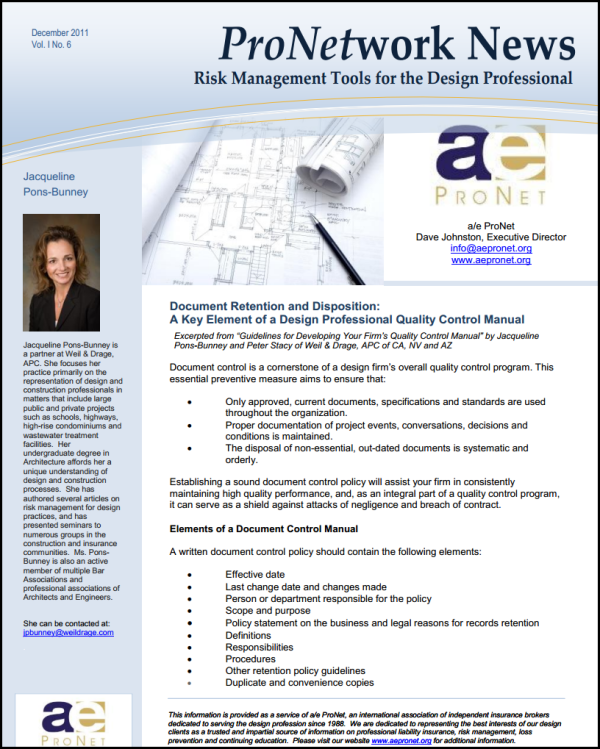 Emails. Every work-day, we read, write, and respond to dozens of them. Some are no longer than a single sentence, but that sentence may turn out to be a vital one, especially in the event of a claim. Today, expectations for document retention are higher than ever, and the penalties for failing to meet those expectations in the event of litigation are correspondingly severe.
Emails. Every work-day, we read, write, and respond to dozens of them. Some are no longer than a single sentence, but that sentence may turn out to be a vital one, especially in the event of a claim. Today, expectations for document retention are higher than ever, and the penalties for failing to meet those expectations in the event of litigation are correspondingly severe.
Knowing what you can (and must!) do with your electronic documents is important. We hope the following excerpt from the December issue of ProNetwork News, Document Retention and Disposition: A Key Element of a Design Professional Quality Control Manual, will answer a few of your questions to this end:
Excerpted from “Guidelines for Developing Your Firm’s Quality Control Manual” by Jacqueline Pons-Bunney and Peter Stacy of Weil & Drage, APC of CA, NV and AZ
Electronic Documents
As we increasingly function in virtual or paperless environments, the retention of electronic information has become a hot topic. Courts have imposed damage awards and penalties on companies that have stalled in discovery or failed to maintain and/or purged such information in anticipation of litigation. Further, there are regulatory and contractual requirements that make an electronic document policy a must.
With the passage of document tampering and destruction provisions of the Sarbanes-Oxley Act and recent amendments to the Federal Rules of Civil Procedure, every company is required to have someone with knowledge of the storage and retrievability of electronic records.
Emails in particular are extremely important in litigation discovery, but please note that they are not the only electronic files in your firm. You will have to apply your e-document policy to Internet downloads, instant messaging, text messages, Websites, e-faxes and on-line bulletin board postings. They all need to be retained in some format/location for generally the same length of time as hard copy documents, and you will need to address retention, destruction, system requirements and storage capabilities, monitoring and enforcement.
Here are some basic steps towards formulating an e-document policy:
- Consult with your IT staff or outside firm about current system capacities and procedures.
- Consider volume, usage, existing archiving (locally and system-wide) and time expended on existing and potential procedures.
- Review both legal/regulatory and contractual requirements.
- Establish procedures for purging emails from local hard drives, the company’s system and separate servers.
- Address implementation (automatic v. manual) and enforcement.
Remember that the policy with respect to the destruction of e-documents, just like hard copies, must be suspended once there has been a notification of litigation or if it is reasonably anticipated.
It is important to consult with legal counsel, and in the case of e-documents, with an IT expert, to determine the scope and content of document retention and disposal policies and procedures. Then, tailor them to your employees, your clients and your fields of practice. The risks and costs of failing to address the retention of both hard copy and electronic information are too great to be ignored.
The full-length PDF version of this newsletter includes many more helpful tips.
ProNetwork News is the latest value-added resource produced by a/e ProNet. Each monthly edition includes an informative and timely article relevant to the design industry and authored by an industry expert. Contact your local a/e ProNet broker for early access to these excellent newsletters.


